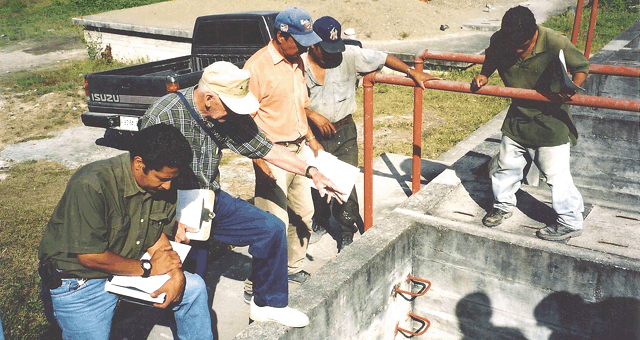Difference between revisions of "Centralized treatment"
| Line 1: | Line 1: | ||
[[Image:water treatment plant.gif|thumb|right|350px|In 2001 CESO Adviser Jake Dick travelled to Santa Rosa de Copan, a city nestled in the western mountains of Honduras, to restore an abandoned water-treatment plant to functionality. Photo: [http://www.ceso-saco.com/About/News/2010/Water-Story-Title.aspx Ceso/Saco.]]] | [[Image:water treatment plant.gif|thumb|right|350px|In 2001 CESO Adviser Jake Dick travelled to Santa Rosa de Copan, a city nestled in the western mountains of Honduras, to restore an abandoned water-treatment plant to functionality. Photo: [http://www.ceso-saco.com/About/News/2010/Water-Story-Title.aspx Ceso/Saco.]]] | ||
| + | |||
| + | |||
| + | |||
| + | [[Image:plant Iraq.gif|thumb|right|350px|In 2007, over 3,000,000 people benefited directly from the [http://www.icrc.org/eng/index.jsp ICRC]’s repairs, renovations and upgrades of water storage and delivery systems in Iraq. Iraq, Basra. Renovating a water-treatment plant. Photo: [http://www.icrc.org/eng/resources/documents/photo-gallery/photos-water-habitat-170308.htm © ICRC / irak.] | ||
| + | |||
In this strategy, the population is supplied with drinking water from large, centralised water treatment plants. The treated water is piped to all the communities in the geographical area served by the treatment plant, thus requiring an extensive pipe network, so as to reach even the most remote communities. The treatment plants could be managed and operated by the larger municipalities or, more likely, by the Water Boards in that region. Generally, these plants should be well managed and operated effectively due to availability of sufficient O&M funds and qualified human resources. | In this strategy, the population is supplied with drinking water from large, centralised water treatment plants. The treated water is piped to all the communities in the geographical area served by the treatment plant, thus requiring an extensive pipe network, so as to reach even the most remote communities. The treatment plants could be managed and operated by the larger municipalities or, more likely, by the Water Boards in that region. Generally, these plants should be well managed and operated effectively due to availability of sufficient O&M funds and qualified human resources. | ||
Revision as of 19:26, 18 May 2012

[[Image:plant Iraq.gif|thumb|right|350px|In 2007, over 3,000,000 people benefited directly from the ICRC’s repairs, renovations and upgrades of water storage and delivery systems in Iraq. Iraq, Basra. Renovating a water-treatment plant. Photo: © ICRC / irak.
In this strategy, the population is supplied with drinking water from large, centralised water treatment plants. The treated water is piped to all the communities in the geographical area served by the treatment plant, thus requiring an extensive pipe network, so as to reach even the most remote communities. The treatment plants could be managed and operated by the larger municipalities or, more likely, by the Water Boards in that region. Generally, these plants should be well managed and operated effectively due to availability of sufficient O&M funds and qualified human resources.
However, implementation of large and centralised drinking water treatments in developing countries is highly unlikely due to investments, civil construction, maintenance of infrastructures and availability of chemicals that are required. As a consequence, people in many developing countries are forced to consume water directly from natural sources or apply household water treatments as chlorination, solar disinfection or boiling, that have low cost but variable effectiveness.
Centralised water treatment and a piped distribution network have had a mixed history primarily due to high initial costs and operation and maintenance, inadequate access to training, management and finance sufficient to support a fairly complex system for the long term. These complete systems are also slow to be implemented so waterborne disease continues in the interim.
Costs
- Centralized water treatment plants cost around $700 per family, making them prohibitively expensive for developing countries to build.
Acknowledgements
- J.M. Arnalà , B. Garcia-Fayos, G. Verdu, J. Lora. Ultrafiltration as an alternative membrane technology to obtain safe drinking water from surface water: 10 years of experience on the scope of the AQUAPOT project. Polytechnic University of Valencia, Chemical and Nuclear Engineering Department, Camino de Vera s/n 46022 Valencia, Spain. May 2008.
- Shedding Light on Clean Drinking Water. EPA.
- Safe drinking water production in rural areas: a comparison between developed and less developed countries.
